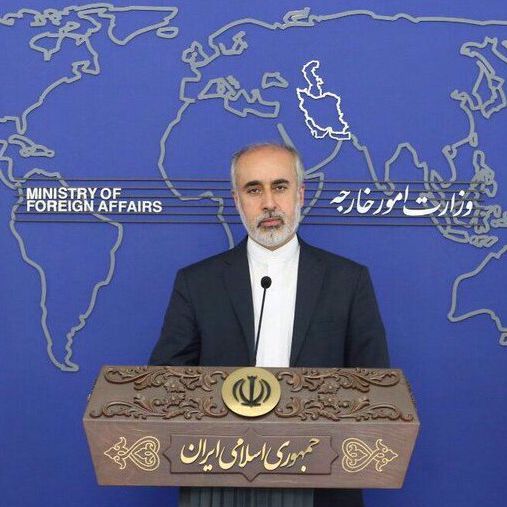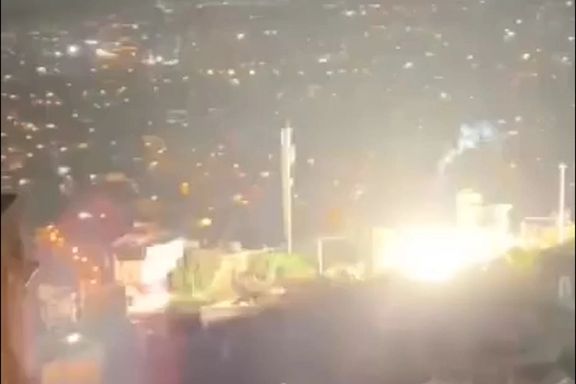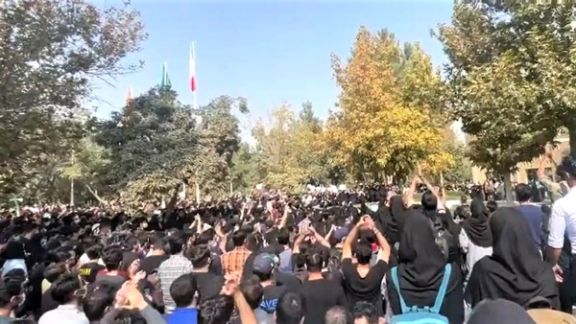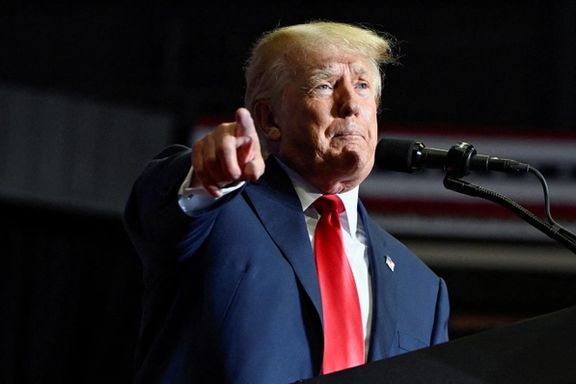Several Iranian State TV Figures Leave For Supporting Protests

A number of TV show hosts and presenters of the Iranian state television have resigned or been fired following their support for the ongoing nationwide protests.

A number of TV show hosts and presenters of the Iranian state television have resigned or been fired following their support for the ongoing nationwide protests.
As the Islamic Republic’s authorities are cracking down on people who are protesting against the government, they are also threatening or arresting celebrities who have voiced support for the protests.
Mojtaba Pourbakhsh, a presenter in a popular football show, was banned from the state TV because he expressed support for football star Ali Karimi, who has been very critical of the regime’s heavy-handed clampdown since the beginning of the current wave of the protests, triggered by the death of 22-year-old Mahsa Amini in hijab police custody.
Many celebrities have been summoned for questioning, or their passports have been confiscated, because of their social media posts demanding freedoms or calling on security forces to stop violence.
Amid the ongoing crisis in Iran ‘reformist’ commentator Abbas Abdi said in an interview on Sunday that what Iran's state-run television broadcasts are “sheer propaganda." Those who are looking for news in Iran will not turn to the state TV, Abdi argued.
Ironically, when hackers interrupted the state TV news program October 8, playing a short clip, most Iranians found out about it through social media reports or on foreign-based satellite TV rather than watching the actual program on the state TV.
Meanwhile, former Vice President Mostafa Hashemi Taba has argued in another interview that the state TV, also known as the Islamic Republic of Iran's Broadcasting organization (IRIB) excels in keeping Iranians uninformed about developments.

Tehran on Monday rejected any connection between nuclear talks with the West and protests in Iran, insisting that the internal situation does not concern others.
“European countries and America have linked the negotiating process to recent issues in Iran. The internal issue in Iran concerns the government and the people. We will not allow any country to meddle in Iran’s internal affairs,” foreign ministry spokesman Nasser Kanaani told reporters in Tehran.
As fierce antigovernment protests have entered their fourth week and close to 200 protesters are reported to have been killed by security forces, European countries, the United States and Canada have warned the Islamic Republic not to use force against its citizens.
Washington, Ottawa and the European Union have issued statements and some sanctions against those Iranian officials who have been identified as responsible for using repressive measures against protesters.
Kanaani stressed that as far as Tehran is concerned, the nuclear talks are not related to the protests and Iran is ready to continue the process.
Negotiations that the Biden Administration started in April 2021 to return to the Iran nuclear deal or JCPOA came to a halt before the current protests began in mid-September. The EU had presented a draft agreement in early August to Tehran and Washington based on 17 months of talks, but after several rounds of exchanges, Washington said that Tehran’s position was too far from bridging the gaps.
The onset of protests following the killing of Mahsa Amini after her arrest by the notorious ‘morality’ police, and a strong international reaction to the incident already signaled that chances for a nuclear deal further diminished.
While Amini’s killing became an important issue, Tehran’s violent reaction to protesters made the situation more complicated.
Any nuclear deal would mean lifting crucial sanctions that would hand tens of billions of dollars to the Islamic Republic, an untenable proposition in the current atmosphere.
Kanaani defended the actions of the clerical government, saying that authorities are defending “people’s security” and the United States and Europe are intervening in Iran’s internal affairs by advocating for human rights. He referred to a few incidents in Western capitals where Iranian protesters have tried to enter Islamic Republic embassies. He argued that the West has double standards, telling Iran not to use violence against protesters but allowing attacks on embassies.
Both in France and Britain police intervened on a few occasions not to allow any breach of embassy grounds by protesters. In September, French police used tear gasand attacked protesters near the Iranian embassy.
Meanwhile, the protests in Iran have gone much farther that the issue of Amini’s death in police custody. Numerous videos from demonstrations across the country show that protesters want an end to the Islamic Republic or clerical rule, demanding full social and political freedoms.
The 83-year-old ruler Ali Khamenei has become a particular target of protests, with people in the streets chanting, “Death to Khamenei” or “Death to the dictator.”

Unrest across Iran Saturday and the opposition’s show of strength were followed by more protests Sunday in some cities including Tehran, Sanandaj, and Mahabad.
Kurdish towns and cities in western Iran were restless all-day Sunday, after government agents killed two men in Sanandaj the previous day. This fueled more intense protests in the city and Security forces resorted to the full use of military weapons Sunday night.
Social media reports spoke of an undetermined number of people killed and wounded among protesters. One protester tweeted, “We pushed them back and it feels like a revolution”.
Security forces, mainly the Revolutionary Guard, were firing automatic weapons till the early hours of Sunday in Sanandaj, a city that was one of the first to rebel in mid-September after the now iconic face of the protests, Mahsa Amini was killed after being arrested the by the notorious ‘morality’ police.
Gunfire in Sanandaj, Sunday, October 9
Protesters also took to the street again in the evening in Tehran’s southern working-class areas such as Shahrak-e Vali Asr and Nazi Abad where angry protesters turned out in such huge numbers that astonished everyone, including security forces who feared the situation could get totally out of control if they interfered. Protesters torched a building used by the IRGC-linked Basij militia which are always deployed to suppress protests.
Social media reports say in Nazi Abad security forces fired shotguns to disperse a group of protesters who were chanting against Supreme Leader Ali Khamenei to prevent the crowd from coalescing.
In other places such as Tehran’s western Ekbatan neighborhood, a massive apartment complex, people chanted “Down with the Dictator” even louder than previous nights and called on the “silent-ones” to join the protests.
Disturbing footage on social media Sunday of security forces vandalizing private cars on thee streets.
The Oslo-based Iran Human Rights Organization (IHR) reported Saturday a death toll of 185 in the protests that started three weeks ago, including at least 19 children, across the country with the highest number of killings in the southeastern province of Sistan and Baluchistan province where half the deaths have been recorded.
There is no reliable information on the number of the wounded as most of those injured in the protests are not taken to hospital for fear of being arrested.
Several protesters were killed during the protests Saturday including at least two young men in Sanandaj, capital of Kordestan Province. One of the victims, Yahya Rahimi, was shot in the head inside his car because he was honking his horn in support of the protesters on the street.
Students also continued their strike and further protests Sunday in several universities in Tehran as well as Rasht, Arak, and Qazvin during the day.
Students, both in universities and secondary schools, also tried to consolidate some of the ground they have gained. Women and girls continue to refuse to wear headscarves. In a university in Tehran men and women broke the forty-year segregation taboo as they had promised, taking over the canteen, and chanted “Don’t be mistaken and think it’s only today. We’ll be doing this everyday!”
Activists have reported pressure and intimidation on secondary school girls in some areas for refusing to wear headscarves and chanting anti-regime slogans. In some schools children have been threatened with expulsion. Security forces reportedly tried to enter some schools Sunday to arrest students but faced resistance from the children, who booed them and chanted “Women, Life, Freedom”, as well as their parents.
There are some unconfirmed reports of disobedience among security forces. Hardliner lawmaker Mohammad Esmail Kowsari, an IRGC general, on Sunday threatened security forces of consequences if they did not “fulfil their duties” during the crackdown on popular protests.

German Foreign Minister Annalena Baerbock said Sunday that Berlin will ensure the European Union freezes the assets of those responsible for a violent crackdown on antigovernment protests in Iran.
She told German Sunday newspaper Bild am Sonntag that "Those who beat up women and girls on the street, who abduct, arbitrarily imprison and condemn to death people who want nothing other than to live free -- they stand on the wrong side of history."
Expressing support for protesters she said, "To those people in Iran we say: we stand by you, and will continue to do so," she said.
Antigovernment protests began on September 17 following the murder of Mahsa Amini and soon turned into the biggest challenge to Iran's clerical leaders in years, with protesters calling for the downfall of Supreme Leader Ali Khamenei.
Germany, France, Denmark, Spain, Italy and the Czech Republic have submitted 16 proposals for new EU sanctions against Iran for its clampdown on protests ignited by the death in hijab policy custody of the 22-year-old Kurdish girl.
The EU foreign ministers are set to decide on the measures at their meeting on October 17, with no resistance expected from the members of the bloc, Spiegel magazine reported. "We are now working flat out to implement these proposals," a German foreign ministry source said.

Former US President Donald Trump has expressed support for the current uprising in Iran, saying that he and his supporters are with the people of Iran.
Addressing his supporters during a rally in Minden, Nevada, on Saturday, he said that “the people of Iran are bravely protesting against their corrupted and brutal regime, courageously facing down violence, persecution, jail, torture, and even death.”
He added that “we are with you and we will always be with you.”
While protests are going on in Iran amid a bloody crackdown by security forces, foreign governments and officials are promising sanctions and punitive measures against the Islamic Republic’s authorities, especially those involved in the suppression of the popular protests.
Oslo-based organization Iran Human Rights said on Saturday that at least 185 people have been killed in the uprising ignited by the death in custody of 22-year-old Mahsa Amini. The NGO added that about 20 of the killed were minors.
The protests first erupted in Mahsa Amini’s hometown Saqqez and capital Tehran and soon spread to all over the country and garnered support from Iranian expatriate communities around the world as well as foreign governments and officials.
The Persian hashtag to express support for the protests has been retweeted over 270 million times and is still being used.

Hardliner Iranian lawmaker Mohammad Esmail Kowsari has threatened security forces of consequences if they “do not fulfill their duties” during the crackdown on popular protests.
Kowsari who was also a Revolutionary Guard (IRGC) commander in charge of Tehran’s security for many years, said, “If security officials do not fulfill their duties, they should be accountable to their commanders and the people."
The General was the commander of the IRGC’s Sarallah (Sar-Allah) Headquarters in Tehran and currently serves as Tehran’s representative in the parliament.
Describing the protesters, who have been holding antigovernment rallies since the death in custody of 22-year-old Mahsa Amini, as “rioters,” he said there are some attempts “to weaken” the morale of government forces.
He also slammed some former government officials who are now critical of the heavy-handed clampdown, claiming that “these people are not aware of the behind-the-scenes issues of the recent riots…They think that statements by foreigners are true and that the security and law enforcement forces have committed crimes.”
Several dissident figures from inside Iran and abroad, such as Canada-based activist Hamed Esmaeilion, Mir-Hossein Mousavi who has been under house arrest since February 2011, and exiled Prince Reza Pahlavi have called the military forces to stand behind the nation.